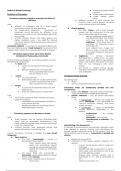Class notes
Class notes for Vphy Veterinary Physiology: Blood Physiology
- Course
- Institution
- Book
It mainly covers blood physiology and includes important details regarding circulation or circulatory system. Also tackles blood coagulation, erythrocytes formation etc.
[Show more]



